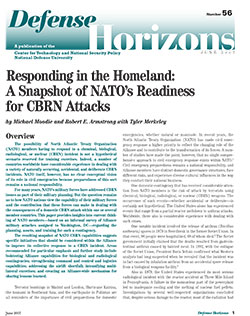DOWNLOAD PDF
 Overview
Overview
The possibility of North Atlantic Treaty Organization (NATO) members having to respond to a chemical, biological, radiological, or nuclear (CBRN) incident is not a hypothetical scenario reserved for training exercises. Indeed, a number of countries worldwide have considerable experience in dealing with a variety of naturally occurring, accidental, and deliberate CBRN incidents. NATO itself, however, has no clear conceptual vision of its role in civil emergencies because preparedness of this sort remains a national responsibility.
For many years, NATO’s military forces have addressed CBRN issues as part of their military planning. But the question remains as to how NATO nations view the capability of their military forces and the contribution that these forces can make in dealing with the consequences of a domestic CBRN attack within one or several member countries. This paper provides insights into current thinking of NATO members—based on an informal survey of Alliance military attaches assigned to Washington, DC—regarding the planning, assets, and training for such a contingency.
The resulting snapshot of NATO CBRN capabilities suggests specific initiatives that should be considered within the Alliance to improve its collective response to a CBRN incident. Areas recommended for particular emphasis and further study include bolstering Alliance capabilities for biological and radiological contingencies; strengthening command and control and logistics capabilities; addressing the airlift shortfall; intensifying multilateral exercises; and creating an Alliance-wide mechanism for sharing lessons learned.
READ MORE >>